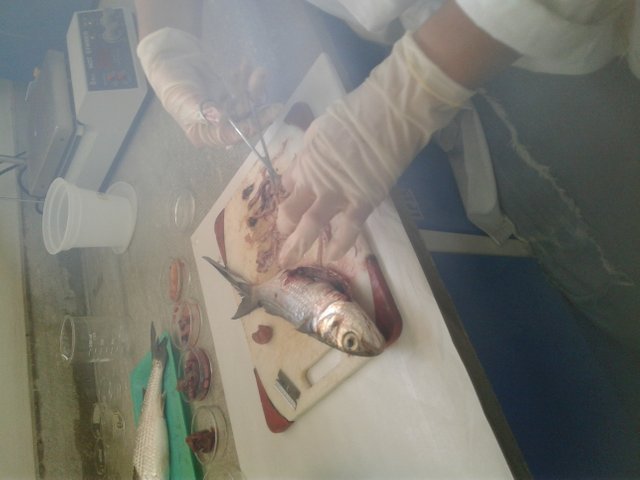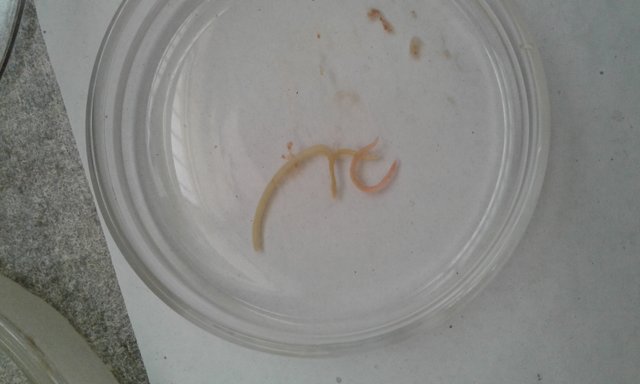"I LOVE IT CEVICHE"
Ceviche, who does not want to eat it? Well, I am one of those who gets her mouthwatering just by thinking about it. My husband prepares it very well. I love it; however, every bite that I put into my mouth, is accompanied by the shooting thought: Will it have parasites? Yes, being a parasitologist is extremely distressing because your thoughts revolve and turn in that direction affecting almost all aspects of your life. But as hunger and gluttony are more powerful than knowledge, the latter always ends up defeated by the tasty ceviche.
Fotography: take for my and my student in the laboratory work

Well, the reader should know that I am not a cook, but I am going to talk about parasites. This tasty dish made of raw fish marinated with lemon and seasoning can transmit parasitical diseases that belong to the Anisakidae family, from which they stand out: Anisakis Simplex, Pseudoterranova sp. and Contracaecum sp. It turns out that the larvae of these parasitical families live in the intestine of fish such as sardine, mullet, lebranche, sole or hake and when the quantities are big, these larvae cross the intestinal walls and travel to the muscles of the fish which is what we eat.
Parasites of the Anisakidae family use marine mammals as their main hosts and during their life cycle can infect a variety of fish species commonly consumed where larvae L1 to L3 develop. Human beings can become a paratenic host by eating fish (raw or semi-raw) with anisakids. The larvae (L3) can penetrate the mucosa of the digestive tract causing lesions that cause the clinical picture of anisakidosis (Rello et al. 2004).Fotography: take for my and my student in the laboratory work
When a person is infected with these larvae can feel an acute abdominal pain, nausea, vomiting, fever and diarrhea, which are very unspecific symptoms, so it is easily mistaken by any other intestinal process or indigestion. A consequence of this is that it is not treated or reported in the proper way, and only sometimes when the person reports having consumed raw or half-roasted fish is it possible that the doctor may suspect that it is an anisakidosis case. Moreover, it can turn out that the person who has suffered a first infection may be susceptible to proteins present in the parasites attached to fish proteins, so that the next time the person consumes fish that is well cooked and has no parasites, he develops a picture of allergic hypersensitivity of variable severity (Rello et al., 2004, Puccio et al., 2008). Abscesses can also occur in the stomach (Audicana, 2000).
But then you will ask yourself, will we stop consuming fish? No, of course not. Something important that I should mention is that when we buy the fish we should eviscerate it as soon as possible; this way we avoid that the intestinal parasites can go to the muscles. Another important caution is to check the fish, because the parasites are usually rolled up in the muscles. They are white or pink and we can possibly visualize themReferences
• Audicana B. 2000. Anisakis: su papel en la anafilaxia. Alergol Inmunol Clin; 15 (Extraordinario Num. 2): 65-96.
• Pardo CS, Mejía PK, Navarro VY, Atencio GV. 2007. Prevalence and abundance of Contracaecum sp. of Rubio Salminus affinis in Sinú and San Jorge rivers: morfological description. Rev. MVZ Cordoba. 12(1):887-896
• Puccio F, Cifarelli D, Blanco F, López E, Sarmiento L, Ordaz R, Figueroa I, Capriles A, Hagel I, Di Prisco MC, Roque ME, Machado L, Ghezzi ME. 2008. Reactividad alérgic a Anisakis simplex y su asociación con asma bronquial en niños escolares del estado Nueva Esparta, Venezuela. Bol. Mal. Salud Amb. 48(2):145-152.
• Rello FJ, Adroher FJ, Valero A. 2004. Anisákidos parásitos de peces comerciales. Riesgos asociados a la salud pública. An. Real Acad. Cienc. Vet. Andalucía Oriental. 17(1):173-197
Instagram: @vidaparasita


Well, the reader should know that I am not a cook, but I am going to talk about parasites. This tasty dish made of raw fish marinated with lemon and seasoning can transmit parasitical diseases that belong to the Anisakidae family, from which they stand out: Anisakis Simplex, Pseudoterranova sp. and Contracaecum sp. It turns out that the larvae of these parasitical families live in the intestine of fish such as sardine, mullet, lebranche, sole or hake and when the quantities are big, these larvae cross the intestinal walls and travel to the muscles of the fish which is what we eat.
Fish is an invaluable nutritional source, especially in the eastern countries and at the present time has become the most economical alternative to obtain the protein source; nevertheless, such as other foods, can be the cause of a parasitic infection.

Parasites of the Anisakidae family use marine mammals as their main hosts and during their life cycle can infect a variety of fish species commonly consumed where larvae L1 to L3 develop. Human beings can become a paratenic host by eating fish (raw or semi-raw) with anisakids. The larvae (L3) can penetrate the mucosa of the digestive tract causing lesions that cause the clinical picture of anisakidosis (Rello et al. 2004).

When a person is infected with these larvae can feel an acute abdominal pain, nausea, vomiting, fever and diarrhea, which are very unspecific symptoms, so it is easily mistaken by any other intestinal process or indigestion. A consequence of this is that it is not treated or reported in the proper way, and only sometimes when the person reports having consumed raw or half-roasted fish is it possible that the doctor may suspect that it is an anisakidosis case. Moreover, it can turn out that the person who has suffered a first infection may be susceptible to proteins present in the parasites attached to fish proteins, so that the next time the person consumes fish that is well cooked and has no parasites, he develops a picture of allergic hypersensitivity of variable severity (Rello et al., 2004, Puccio et al., 2008). Abscesses can also occur in the stomach (Audicana, 2000).

But then you will ask yourself, will we stop consuming fish? No, of course not. Something important that I should mention is that when we buy the fish we should eviscerate it as soon as possible; this way we avoid that the intestinal parasites can go to the muscles. Another important caution is to check the fish, because the parasites are usually rolled up in the muscles. They are white or pink and we can possibly visualize them
Finally, if we are going to prepare ceviche or sushi, freeze the fish for at least four hours, so the parasite dies and if it is present in the fish, it will not cause harm to humans. If you want to know more about the subject, you can consult the following references:
• Audicana B. 2000. Anisakis: su papel en la anafilaxia. Alergol Inmunol Clin; 15 (Extraordinario Num. 2): 65-96.
• Pardo CS, Mejía PK, Navarro VY, Atencio GV. 2007. Prevalence and abundance of Contracaecum sp. of Rubio Salminus affinis in Sinú and San Jorge rivers: morfological description. Rev. MVZ Cordoba. 12(1):887-896
• Puccio F, Cifarelli D, Blanco F, López E, Sarmiento L, Ordaz R, Figueroa I, Capriles A, Hagel I, Di Prisco MC, Roque ME, Machado L, Ghezzi ME. 2008. Reactividad alérgic a Anisakis simplex y su asociación con asma bronquial en niños escolares del estado Nueva Esparta, Venezuela. Bol. Mal. Salud Amb. 48(2):145-152.
• Rello FJ, Adroher FJ, Valero A. 2004. Anisákidos parásitos de peces comerciales. Riesgos asociados a la salud pública. An. Real Acad. Cienc. Vet. Andalucía Oriental. 17(1):173-197

Congratulations @vidaparasita! You have completed the following achievement on the Steem blockchain and have been rewarded with new badge(s) :
Click here to view your Board
If you no longer want to receive notifications, reply to this comment with the word
STOPCongratulations @vidaparasita! You received a personal award!
You can view your badges on your Steem Board and compare to others on the Steem Ranking
Vote for @Steemitboard as a witness to get one more award and increased upvotes!